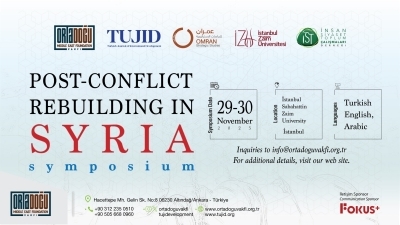Executive Summary
The military bodies that are part of the Autonomous Administration in northeastern Syria receive their inspiration from a number of factors related to the political leanings of the parties that control the region. Thus, the group extracts its legitimacy, not from local demands for its presence, but instead from the urge to achieve certain political ends, including local empowerment and establishment. There are two main references for the group’s project. First, the project references the political ideals of the Democratic Union Party (PYD) and Tev-Dem, formerly known as Rojava KCK, which contributed to the formation of the military units there. Second, it references the direct connection of the military units to the administrative, legal, and executive bodies of the Autonomous Administration.
- The organization into a united structure of the military groups loyal to the PYD happened during two time periods. First in 2004, small groups were formed after the protest movement at the time. These groups were formed in villages and did not form into any official military group as part of the PYD untilthe recent Syrian revolution. The majority of the party’s military activities were directly aligned with the Kurdistan Worker’s Party (PKK), especially on issues like recruitment. The second time period is best identified by the organization of military forces into a united force, known as the Syrian Youth Movement, which was led by Khabat Derik.
- Military control over the armed forces of the Autonomous Administration is due to a combination of internal factors, including a joint effort between the Assad regime and the Autonomous Administration to establish stability, as well as support from outside actors, such as the international coalition. These factors did not result in a degradation of the group’s autonomy.
- The YPG and YPJ are the backbone of the military forces in the Autonomous Administration. They depend upon the PKK for their training and military planning. Their force is estimated to comprise between 20,000 and 30,000 fighters. To maintain military hierarchy and organizational structure, they depend on the experiences and advice of the PKK. The YPG also created two academies, one for men and women respectively. The academy for women is called “Martyr Sheelan Academy.”
- The Autonomous Administration started its reform and restructuring of its military units at the beginning of 2017. This was done in coordination with the international coalition and with American support for the Syrian Democratic Forces. The YPG, along with the SDF, also managed to take control of expansive, another factor that resulted in the need for restructuring. The structure they chose to implement is not much different than the YPG’s existing structure, since it is based on their internal bylaws. The YPG does not give accurate public information about its true numbers, but the group has suggested that it comprises approximately 50,000 fighters.
- The HPX is another main fighting force in the Autonomous Administration. This group is composed of citizens who are required to join through the forced conscription program. The Self-defense Council spearheaded these efforts after the Self-Defense and Protection Council provided confirmation through a social contract signed on January 21, 2014. The council’s bylaws were adopted by the legislative council on July 13, 2014.
- The military forces created this structure to “build a well-trained and disciplined military force that would form into an army with official recognition and organized with a clear hierarchy,” according to Rizan Kilu, a co-president of the Self-Defense and Protection Committee in Jazira.
- In Jazira Canton, there were 29 training courses offered between November 20, 2014 and July 21, 2017. In the Ain Arab Canton there were 8 training courses offered between June 6, 2016 and October 10, 2017. In the Afrin canton there were 10 training courses offered between July 5, 2015 and June 5, 2017.
- After the training program, the Self-Defense Council depends on the conscripted fighters to provide various services, offer logistical support to the YPG, and construct or renovate military academies and buildings.
- The Self-Defense Council in Afrin trains special forces at a higher rate than other cantons. These special forces are recruited and trained from among the conscripted locals. Three groups of special forces in Afrin have graduated as of the date of publication of this report.
- At age 18, males are required to serve a minimum amount of time and are not excused, unless they have special permission or they reach the age of 40. Women are allowed to volunteer.
- The Military Discipline Units of the Self-Defense Council are the military police. They pursue defectors and others who have failed to report for service. They also carry out some court orders alongside the conscription office.
- There are also a number of foreign groups that fight alongside the YPG. One such group is the International Freedom Battalion, formed in Ras Al Ayn on June 10, 2015. The members come from a number of countries and ideologies, including Turkish leftists (MLKP) and the Liberation Army of the Workers and Peasants of Turkey (TIKKO). There are also members of leftist movements from Europe that formed the Bob Crow Brigade and the Henri Krasucki Brigade.
- Some of the Christian forces in Hasakah province are allied with the YPG. Their military alliances are determined according to three main factors, 1) ethnic identity, including Christian Arabs and those with an independent Christian nationality; 2) the ethnic differences between the Assyrians, Syriac, and Armenian Christians; and 3) the different Christian dogmas and their affiliations with different churches.
- The Asayish were formed as a central security force when the People’s Council of West Kurdistan (MGRK) took over cities populated by Kurds in the area. They started their official operations after the regime pulled out of Ayn al Arab (later named Kobani), Rmeilan, Malkiye, and Deirik. Once organized, the Asayish announced their intention to submit to the power of the Kurdish Supreme Committee (DBK), comprised of the Kurdish National Council (ENKS) and the MGRK. They now consider themselves to be a part of the Syrian Democratic Council (MSD) and the Autonomous Administration’s legislative wing. They oversee a number of forces, including the local traffic police, the counter terror forces (HAT), the Women’s Asayish, security checkpoints, general security, and anti-organized crime operations.
- The Hêzên Antî Teror Asayîşa Rojavayê Kurdistanê (
- The Women’s Asayish first convened on October 26, 2016 with 500 volunteers in Ain al Arab in Jazira canton.
- The Civilians' Defense Forces, or HPC, was named for the Autonomous Administration’s role within the “core of society.” The HPC is responsible for protecting local neighborhoods and the committees that operate in the cantons. The group has its own checkpoints and actively investigates any possible threats in the cantons.
- The Roj Mine Control Organization (RMCO), which coordinates with the demining units in the Asayish, is responsible for disarming all mines, especially in the rural areas where there have been—or still are—active battlefronts. Since 2014, RMCO has cleared 51 square kilometers and destroyed 8,704 mines.
- Not only are the aforementioned military structures the backbone of the Autonomous Administration, but the alliances that the YPG made with foreign and regional powers also contribute to the effectiveness of the military structure. With the YPG as the main force in the alliance, and with the group’s growing importance, the focus quickly shifted to the fight against terror. This fact was confirmed when the International Coalition to fight ISIS in Iraq and Syria designated the YPG as its military partner, leading ground operations.
- At the establishment of the SDF, the groups present included the YPG, YPJ, Sotooro, Jaysh al Thuwar, Syriac Military Council, Sanadeed Army, Raqqa Revolutionary Front, Northern Sun Brigades, Jazeera Brigades, Freedom Brigade, and the 99th Infantry Brigade. After its formation, a number of other groups joined the SDF. These groups included the Free Officers Gathering (Hussam Awak), Manbij Military Council (Manbij Revolutionaries, Jund Al Haramayn Brigade, Euphrates Brigades Gathering, Al Qusay Brigade, Turkmen of Manbij Brigade, and Northern Sun Brigades), and the Army of Tribes. There are special forces allied with the SDF, but they are not officially part of the group.
- The formation of the SDF came two weeks after the Russian intervention in September 2015. On October 12, 2015, two days after the SDF’s formation, the spokesperson for the US Secretary of Defense announced that an American C17 landed in Hasaka province to deliver more than 100 containers of military supplies.
- According to unofficial sources, the American weapons delivery was organized by Lahor Sheikh Jinki, the nephew of the late Jalal Talabani.
- At the same time as the SDF’s formation, the YPG was expanding its control of majority-Arab territories in rural Hassaka, Raqqa, and Afrin. Only 11 days earlier, the Americans announced the termination a program to train and equip Syrians due to a decision to call back some troops from foreign training missions.
- American support for the SDF is a main factor contributing to the group’s strength and capacity. The US provides air support, protects YPG forces from attacks, and sends experts, advisers, marines, and other American troops to SDF territories.
- These trends were supported by the continued leadership of the coalition, which offered increased armed support to Syria's Democratic Forces and the YPG through the construction of a five or six military bases in the countryside of Hasaka, Aleppo, and Raqqa. The US provides three main types of support for the SDF—arms, military bases, and protection from enemy advances.
- The SDF consulted more than 500 foreign advisers, primarily from the US, France, and the UK to a lesser extent. These advisers helped train the SDF and YPG.
- There are approximately five to six moving and permanent American military bases in northern Syria.
- The SDF does not publicize accurate information about its numbers. Instead, Omran’s research team depends on public statements, which provide hints that uncover more accurate information. Often, SDF commanders speak to friendly local media and exaggerate the group’s true numbers. Rough estimates suggest that the group comprises 60,000 to 75,000 fighters.
- On January 1, 2016, the SDF began recruiting fighters by accepting volunteers, offering monetary compensation, and forcing others to join through conscription. The group has trained and graduated 12 groups since February 16, 2017. The graduates were from Shadadi, Raqqa, and Deir Ezzor.
- After the formation of the SDF, new fighters directly joined the military structure, instead of joining groups that operated under the SDF banner. The SDF leadership even used force to stop people from joining such groups, as was the case with the special forces of the Tayyar Al Ghad. It is notable that the Christian Forces and the Sanadeed Army are not held to the same standard.
- The SDF structure includes the following components: the Military Council (which includes leaders from all member groups), the SDF General Commander, the General Command of the SDF (led by the General Commander and 9 to 13 members, depending on need), and the Military Discipline Committee. Unlike the YPG, the SDF did not form separate military units, except for the Jaheesh Tribe, which formed a special force of 200 tribesmen independent of the SDF.
- The SDF has not completely integrated of all their forces, for the same reasons that the Syrian opposition groups have failed to do so for six years. The groups that have joined the SDF have, in fact, not separated completely from their original structures.
- The SDF was created from a mixed alliance of groups including tribes, as well as groups that were not tribal in nature but had formed in Raqqa and rural northern Aleppo. There are also some religious groups, like Christian forces, and others built upon nationalistic visions.
- There are major differences between the main force of the SDF and the YPG, and they continue to face difficulties due to this reality. Currently, there is not active armed conflict between the YPG and other groups that are part of the SDF, but some of the problems are rooted in previous conflicts. For example, there was a conflict between the YPG and the Sanadeed Army. During the Raqqa operations there were also tensions between the YPG and the special forces controlled by the Tomorrow Movement.
- The Raqqa Revolutionaries Front is considered to be one of the oldest allies of the YPG. The group had a central role in taking control of Raqqa from the regime in March 2013.
- The SDF alliance is problematic and will continue to negatively impact local and regional developments, despite the rationale for the SDF’s, its military and security structures, and its alliance with the YPG.
To Read More Click Here



